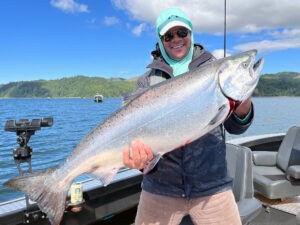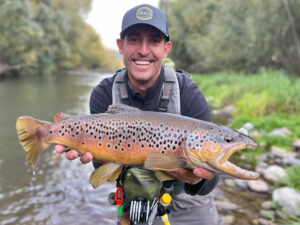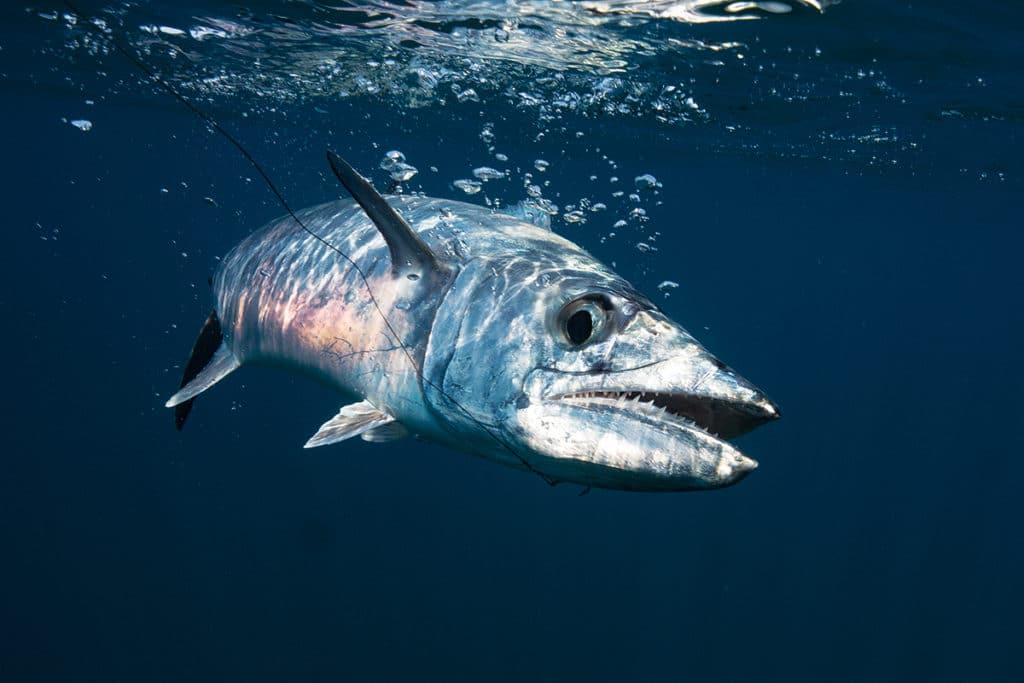
“That is some pretty, pretty water, boys!”
Oscar Garcia backed off his panga’s 200-hp Suzuki as the mouth of Brazos Santiago opened between the jetties of South Padre Island and Brazos Island. The 22-foot raised-prow boat eased off plane to bob along at a putter on a vector parallel to the north jetties, portside. On Garcia’s command, Anibal Gorena and I scooped 8-inch mullet out of the baitwell, nose-hooked them on single-hook wire rigs, and set them over the side. As Garcia held a steady and slow speed, we let out line until the baits were staggered behind us at about 100 feet. Garcia eased along and started a portside turn around the jetty point.
“Don’t get too comfortable,” Garcia warned. “It can happen — now! Your bait, Gonzales!”
Before I could get completely settled in my seat, a slate missile launched out of the water with my mullet squarely in its teeth. It happened in a second flat, but I saw the big king mackerel bite the hapless prey in half, and my line went slack. With a curse, I began to reel the butchered bait back to the boat.
“Drop back!” Garcia said. “He’ll come back around for the rest.”
Just as those last words escaped Garcia’s mouth, my line began screaming off the Shimano Tranx 500HG. After several blistering runs, including one that threatened to dump the whole spool of 40-pound braid, Garcia stuck a gaff in a thick 51-inch king.
As we did a Texas two-step around a thrashing, snapping king mackerel, Garcia looked at me and asked, “Why do folks want to run way the hell out when you’ve got this kind of action 10 minutes from the house?”
Just A Short Boat Trip to the Action

The south Texas coast, most notably from Aransas Pass at the top, to the coastal bend, to Brazos Santiago at the mouth of the Lower Laguna Madre, has long been a haven for the “mosquito fleet,” a colloquialism for the swarms of fishermen operating small (under 22-foot) bay and flats boats in the area. They take advantage of the unique bluewater fishery the region offers beginning in spring and ending with the first major cold front in November. Steady southeasterly breezes and a prevailing current push blue Gulf of Mexico waters very close to shore, often right up to the passes and into adjoining bays. With the clean, nutrient-rich waters comes a plethora of pelagic game fish, including false albacore (little tunny), Spanish and cero mackerel, and prized kingfish.
“There are some nice kings out there starting in spring,” says Joe Montemayor, owner of Joe’s Tackle in Pharr, Texas. “You don’t have the big tankers that you find way offshore — those 40- to 45-pounders — but you have plenty of solid 36- to 44-inch-class kings. You will land plenty over 48 inches when the water temperature hits the 80s in the summer. In a 22-foot bay boat, with three fishermen and a bunch of rods and tackle, a 42-inch king can be plenty big enough.”
“When the water is nice and flat (two feet or less), it isn’t tough to run out of Mansfield Pass and look around for a few kings,” says Capt. Chad Kinney, of Bamm Bamm Charters in Port Mansfield. “We can get out there in the 25-foot Shallow Sport X3 multihull I use for inshore. If fish are out there, the action is fast. We even get them with the same tackle we use for trout and redfish.”
Kayak devotees also get involved in the fun, often putting in right off the jetties or a nearby beach and paddling out the short distance to where Texas kings lurk. At times, kingfish will actually roam farther inside the passes themselves. On the Lower Laguna Madre near Brazos Santiago, it’s not an uncommon situation for an angler casting to trout and redfish to suddenly lose control of his reel to a scorching kingfish before the leader parts.
Fishing During the Morning Hours
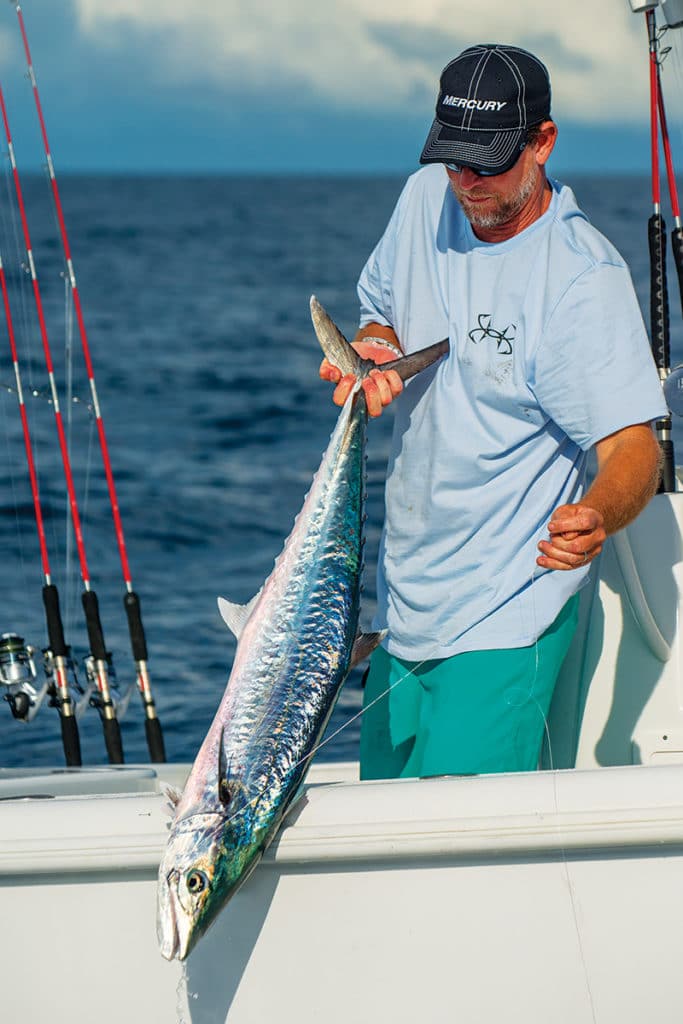
Although there can be days of flat-calm conditions from dawn to dusk, most anglers expect southeast winds to accompany warm spring and summer days along the south Texas coast. By late morning to midafternoon, the seas around jetties and passes can stack up and get sloppy, making for tougher fishing conditions. The wind’s upward velocity curve necessitates that “mosquiteers” plan for an early trip, usually from gray light to whatever time the wind and waves become too uncomfortable to handle.
If Kinney is going to chase kingfish for his clients, he’ll get to Mansfield Pass early and troll a few baits initially. Often he’ll work farther from the jetties and closer to the 1-mile buoy, where the water deepens.
“I’ll usually bump-troll with plugs or ribbonfish,” says Kinney, “but I’m always scanning for some kind of activity on the water, whether it’s a bird working or fleeing fish. I want clues to where there may be active fish and what they may be doing. I’ll investigate anything that looks out of the ordinary.”
Know Your Limits
The Texas Parks & Wildlife Department closely regulates the size and bag limits of king mackerel in Texas state waters. All anglers hoping to fish and retain kingfish must have a current and valid Texas state fishing license with a saltwater stamp. Each licensed angler is allowed to keep two kingfish per person per day, with none shorter than 27 inches measured from the top of the fork.
Another favorite strategy that Kinney uses for mosquito-fleet kingfish is topwater fishing. Remarkably, he uses many of the same topwater plugs that he casts to inshore species, such as speckled trout and redfish. With great success, Kinney has thrown Bomber Badonk-A-Donks, Heddon Super Spooks, and a variety of other walk-the-dog plugs to kings.
“It’s pretty exciting when you see a big king shoot straight out of the water 10 feet high with your plug in its mouth,” says Kinney. A short wire trace, usually about 12 inches long, prevents bite-offs from the snapping jaws of an agitated king mackerel.
If you intend to try your hand throwing topwaters at a mosquito king, make sure you’re properly equipped. Popping rods should be in the upper range of what you would use for redfish, preferably in medium to medium-heavy, and a high-capacity reel is a must for the long runs of belligerent mackerel. My typical nearshore topwater rod is a 7-foot Temple Fork Outfitters medium-heavy casting rod with fast action, paired with Shimano’s Calcutta 200 loaded with 30-pound PowerPro braid. The outfit can handle a 1-ounce River2Sea WideGlide (my favorite topwater plug) and still have the backbone to snub most kingfish.
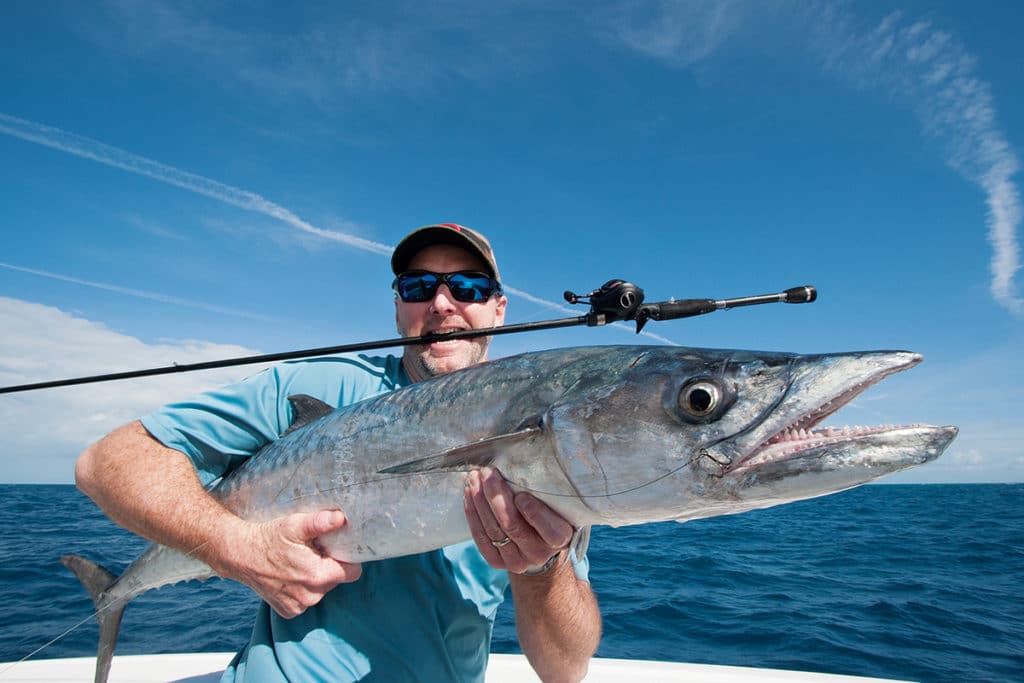
Targeting Larger King Mackerel
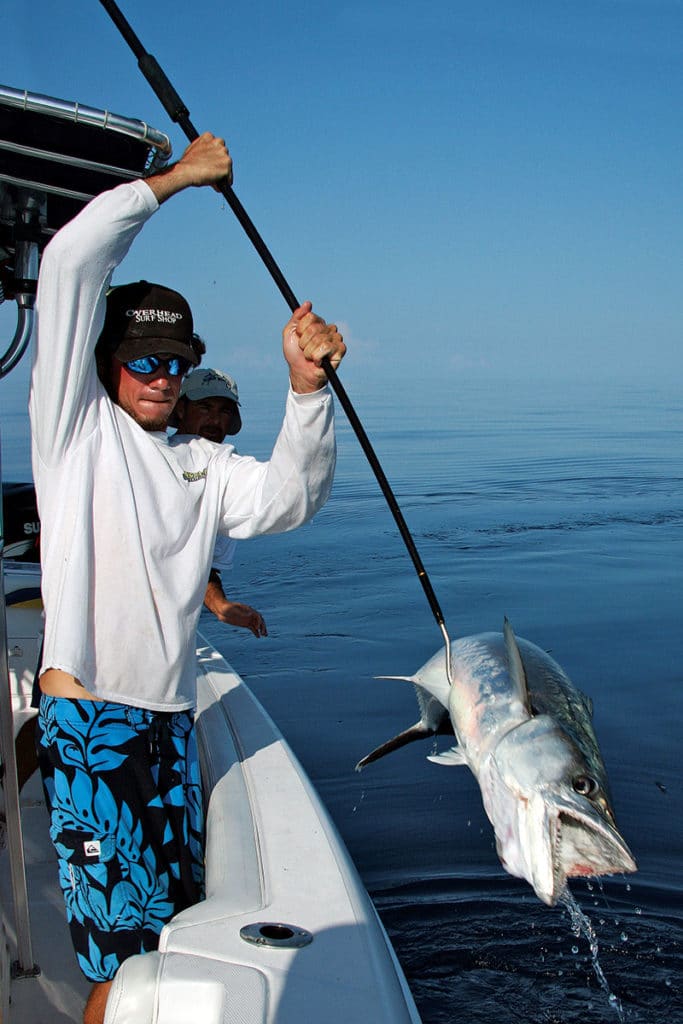
If Kinney knows that there are larger kingfish roaming around just beyond the jetty rocks, he’ll switch to the live baits that bigger fish seem to prefer over lures. When he starts fishing live stuff, he’ll break out the hardtails (blue runners) and live mullet. Again, the order of the day is bump-trolling. If there is a bit of a current or breeze, he might try controlled drifts.
Farther south, around Brazos Santiago, Garcia also uses live bait a great deal. He prefers to net 6- to 8-inch mullet, which he believes are the primary forage for jetty kings. He slow-trolls them around the points of the jetties and along the adjoining beachfront. Rather than using the typical multihook kingfish rig, Garcia prefers a single 10/0 Eagle Claw 190 offset circle hook. He may miss more fish than other anglers who use the multiple-hook rigs, but he believes that the benefits far outweigh the costs.
“First, I don’t miss that many fish,” says Garcia. “I may have an occasional fish bite a mullet in half, but I can drop back and give the kingfish a second chance. The single hook doesn’t tear up a fish. Finally, the last thing you need in a small boat is three or four treble hooks hanging from a fish, even one you’ve whacked a couple of times and gaffed. It’s a safety issue.”
Garcia adds that live mullet swim better with a single hook through the nose. Bridle (floss) rigs might work too, but the jury is still out on how to mitigate the fragile nature of the connection in the presence of sharp teeth.
Trolling tackle for nearshore kings is a tad lighter than the bigger stuff that is popular for huge smokers. Garcia uses Penn Squall 20LW conventional reels loaded with 25-pound Ande, matched to 7-foot medium-heavy Ugly Stik conventional rods. Kinney prefers spinning reels, usually a 6500 Penn Spinfisher spooled with 60-pound braid or 25-pound Ande mono. He likes the latter for the shock-absorbing qualities on an initial fish surge, which mitigate the risk of pulling a hook. “Besides, you don’t want to get your finger against braid when a big king is making a hot run,” he says.
Kayak Kingfishing
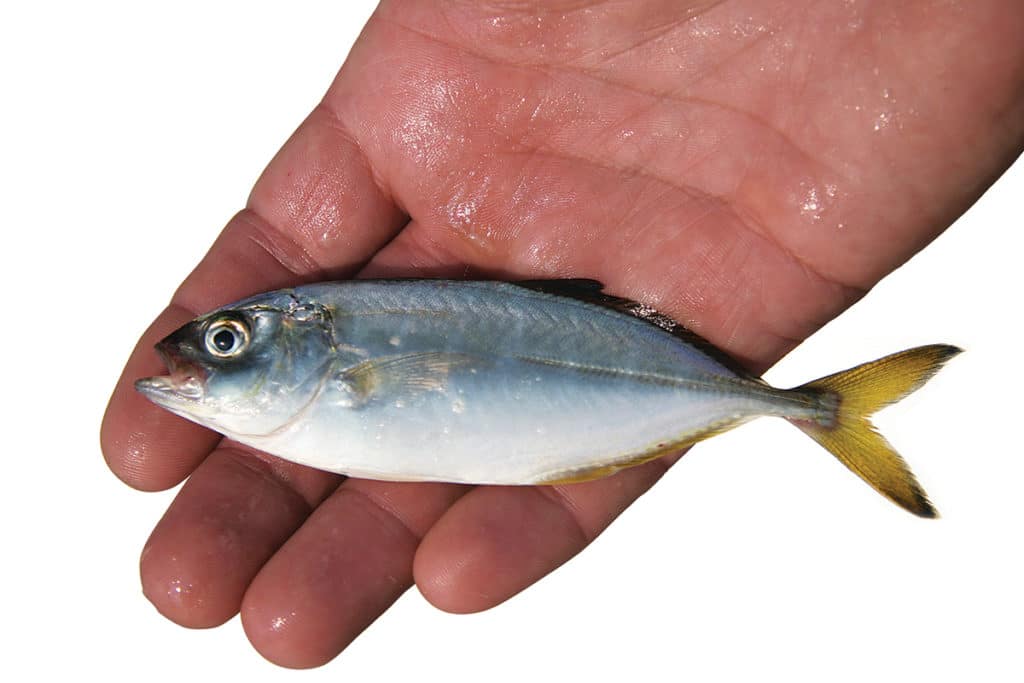
Joe Montemayor, whose tackle shop is a major outlet for Hobie kayaks in the Rio Grande Valley, says that the jetty kingfish blitz time is a favorite season among his kayaking clientele. In the past few years, his inventory and sales of specialized kayaking equipment have risen sharply as the yak population slowly joins the mosquito fleet.
“It’s still an effort to work your way out to the pass and find a big king,” says Montemayor. “Hook it, fight it to the boat with no motor, then gaff it or release it — all the while dodging sharks, other troll fishermen, and big boats heading to the rigs and canyons. But some of my customers love the challenge!”
The kayak is ideal for the slow, almost casual trolling style that Montemayor calls the “yak patrol.” Kayak fishermen troll parallel to the jetties, past the point, and along the surf edge to the third bar and back again. A big, fresh ribbonfish is ideal bait for this application, he says. However, the multihook kingfish rig can be particularly problematic and even dangerous in such intimate quarters.
“I tell a lot of my kayakers they’ll have equally effective results without the extra hooks swinging around by pulling a 1-ounce Rat-L-Trap,” he says. “The steady pace is just perfect to get that lure to vibrate and rattle at the perfect rhythm. Then the only hooks you have to worry about are right in front of the fish, not swinging around your nose and ear.” Montemayor also recommends that his yak customers fish the venerable Russelure spoon and new LiveTarget 1-ounce Pinfish.
If you find yourself on the lower Texas coast sometime between April and November and see sport-fishers gunning for far-off locales, don’t turn green with envy. Turn your skiff or kayak toward the nearest pass and, like a pesky mosquito, provoke a king.
Topwater Action
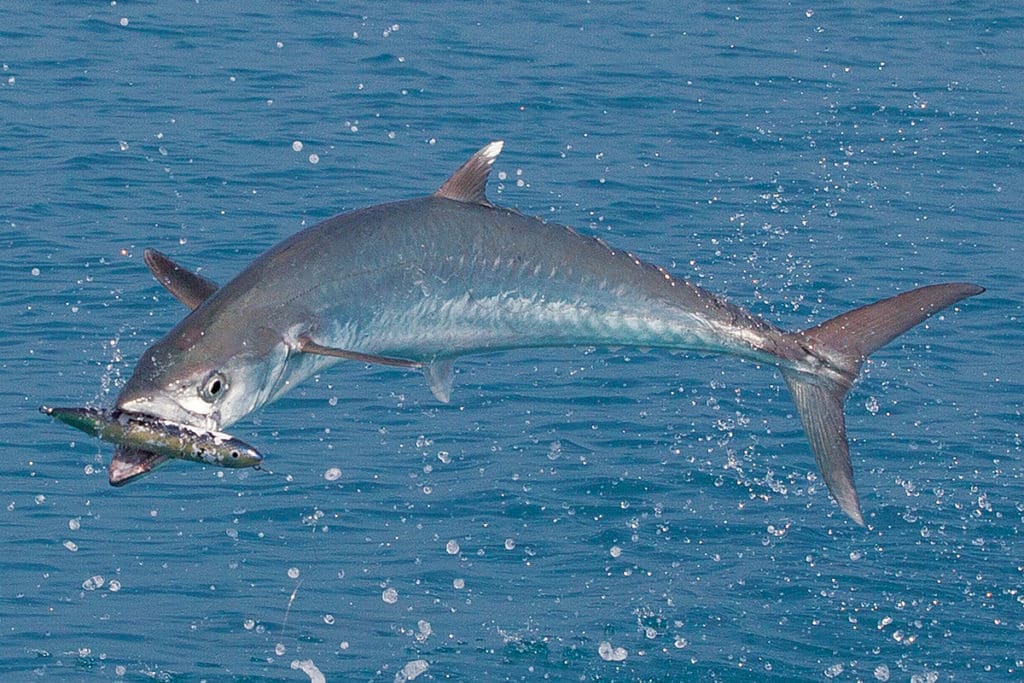
Wire Knot A Problem
Catching Big Tarpon from Kayaks
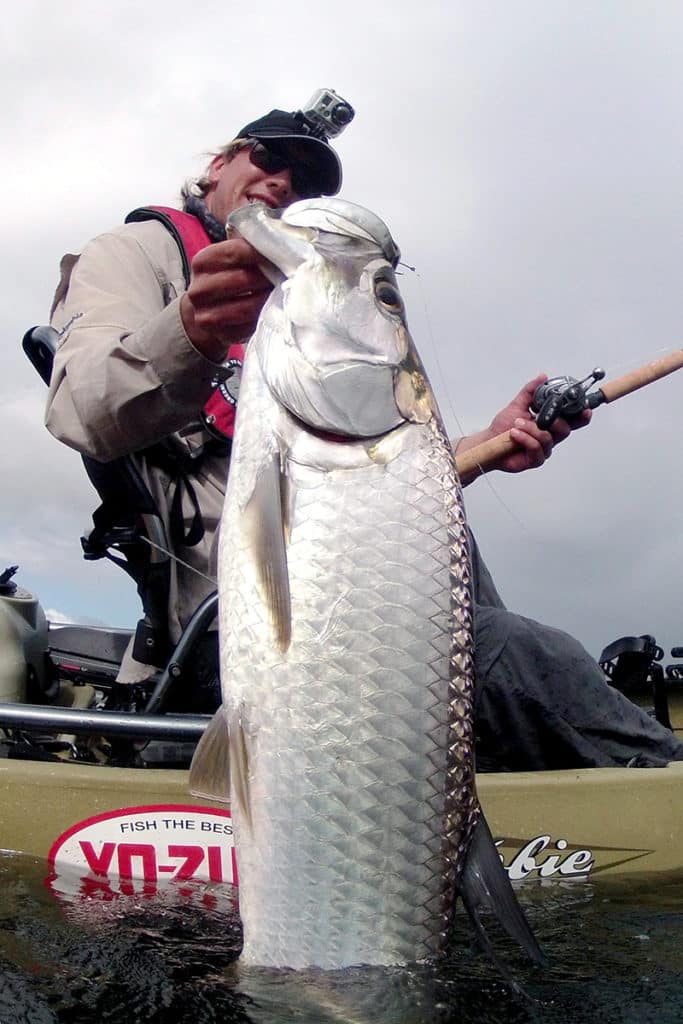
It never hurts to have your favorite popping rod rigged with a topwater or jerkbait on a fluorocarbon leader ready for action. Mackerel aren’t the only kings that hold court during Texas’ mild months. Schools of tarpon of varying size, from acrobatic 20- and 30-pounders to mauling brutes topping 160 pounds, are often spotted rolling in the passes. They can be coaxed into striking a properly presented lure or bait. A large white jerkbait such as a Slug-O or Saltwater Assassin is tough to beat.
On a prior trip, a member of our fishing party, “Gator Dave” Rutledge, was pulling up a mullet to inspect its liveliness. Before he could pull the baitfish out of the water boat-side, the bucket mouth of a 7-foot tarpon closed around it and cherry-picked it off the hook in one loud gulp. No one on the boat said a word for several minutes.
ABOUT THE AUTHOR: Calixto Gonzales is a lifelong angler of the south Texas Gulf Coast. He is the proud owner of a BayQuest 200 center-console named The Teacher’s Pet. You can find him trolling for kingfish all summer long.



